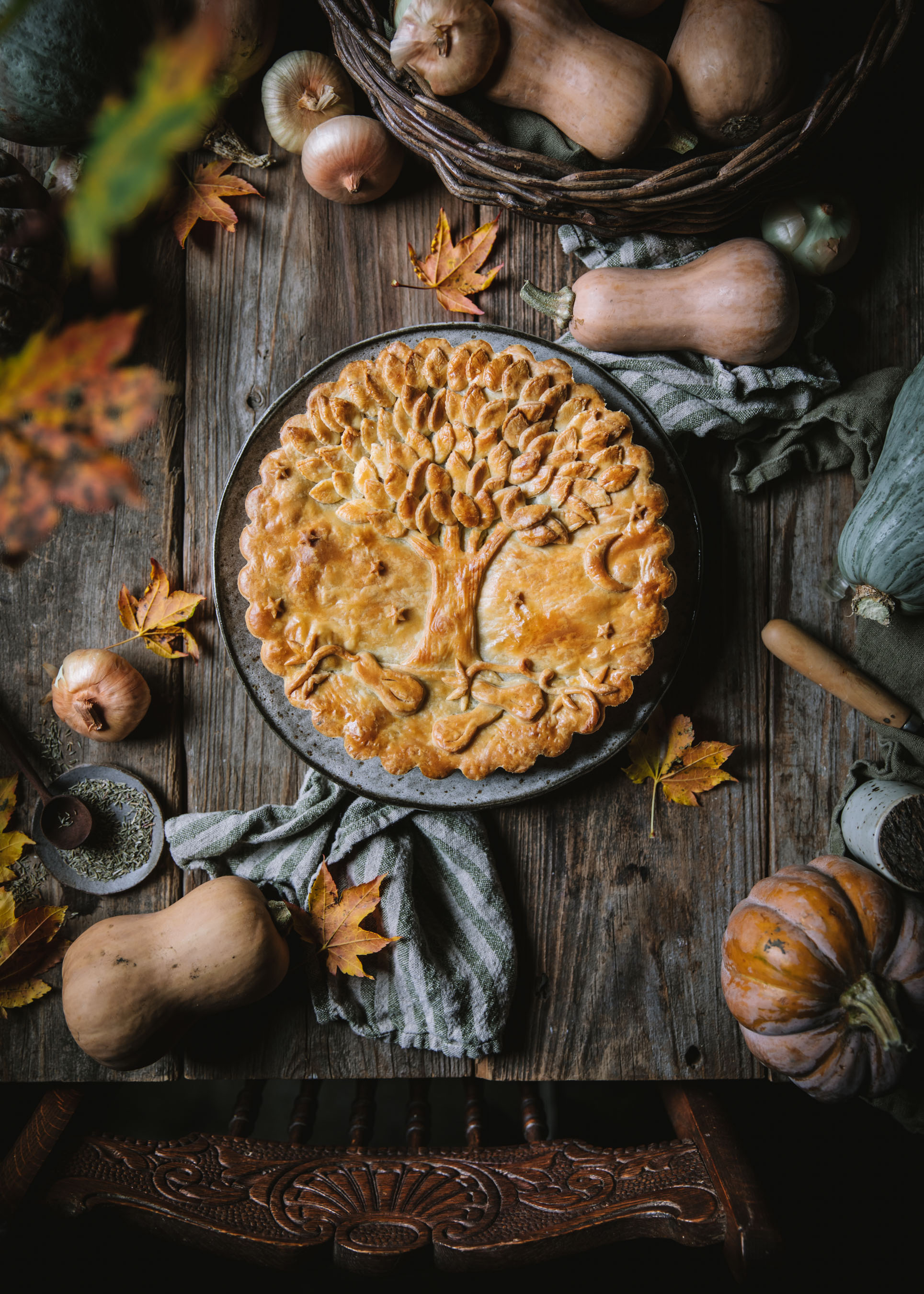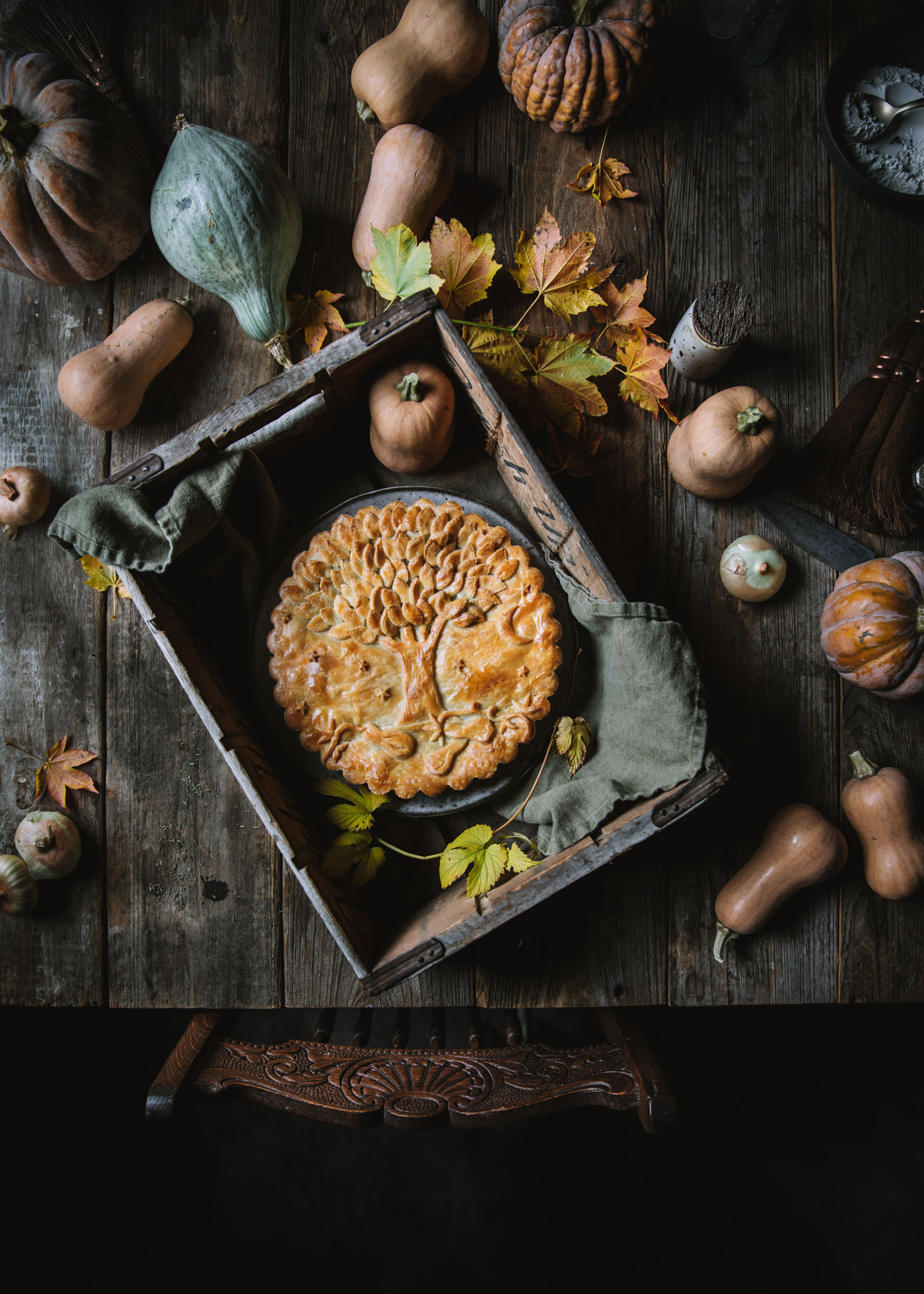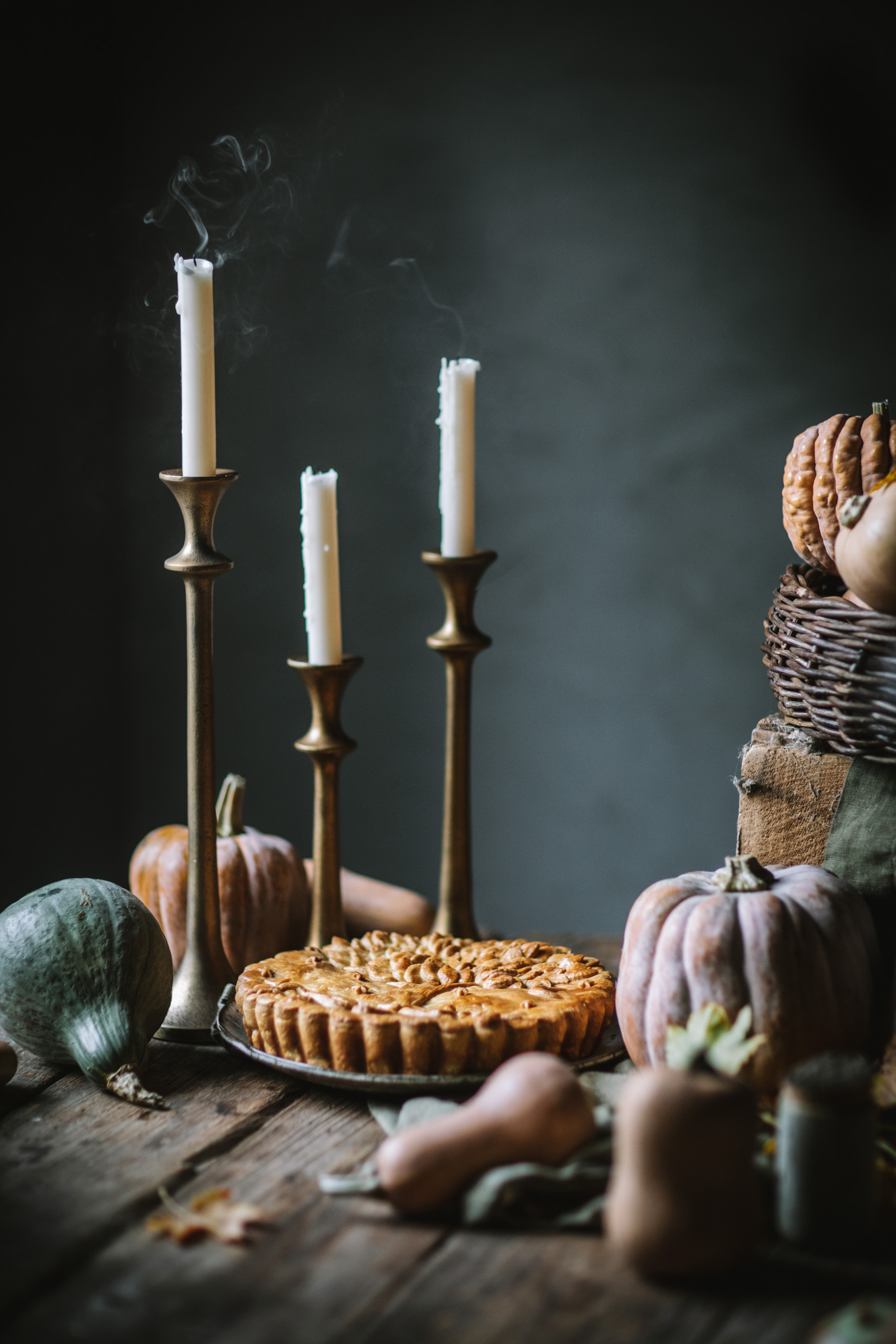
I’m sorry it’s been so long since my last post, time has quite gotten away from me this autumn. I’ve been busy with work projects (speaking of which, Creative Business School is open for enrollment until the 30th), and while I love keeping up with the blog and sharing recipes with you here, I also needed to make sure I was taking the time to enjoy the season while it was around. Spending time with friends, family, foraging out in the woods, and all that good stuff. So thank you for showing me grace with this very belated post. At the very least, this chevre and butternut squash pie recipe is sliding into the finish line of squash season in the northern hemisphere, and it’s also in time for Thanksgiving here in the states, huzzah!
 I know, I know, sweet pumpkin pies are more traditional. But, if you want to mix things up with a savory squash pie instead of a sweet one (or are cooking for a vegetarian), might I suggest this delightfully cheesy and squash-filled flakey pastry. The filling is a flavorful mix of thyme, sage, garlic, caramelized onions, roasted butternut squash, and creamy tangy chevre. As for the pastry, it has a bit of sage in it, as well, and creates a lovely extra seasonal + cozy flavor for the crust. Now, if you’re looking at the top and wondering “do I have to do all that decorating??” the answer is a relieving “no.” You can make the top crust as simple or as decorative as you like! The recipe below does make enough crust for you to cut some fun decorations out of the edge trimmings, so feel free to get creative if you’d like! But no pressure if you want to keep things simple. The butternut squash pie will be delicious all the same.
I know, I know, sweet pumpkin pies are more traditional. But, if you want to mix things up with a savory squash pie instead of a sweet one (or are cooking for a vegetarian), might I suggest this delightfully cheesy and squash-filled flakey pastry. The filling is a flavorful mix of thyme, sage, garlic, caramelized onions, roasted butternut squash, and creamy tangy chevre. As for the pastry, it has a bit of sage in it, as well, and creates a lovely extra seasonal + cozy flavor for the crust. Now, if you’re looking at the top and wondering “do I have to do all that decorating??” the answer is a relieving “no.” You can make the top crust as simple or as decorative as you like! The recipe below does make enough crust for you to cut some fun decorations out of the edge trimmings, so feel free to get creative if you’d like! But no pressure if you want to keep things simple. The butternut squash pie will be delicious all the same.
 With this pie, it’s very important that you cook the filling as directed beforehand, since this helps evaporate a lot of the moisture out of the squash and onions, which will keep you from having a soggy bottom crust. But equally important is to make sure that the filling is *completely cool* before starting to assemble the pie. If the filling is warm, it will start melting the butter in the crust once it touches it and will make the dough very difficult to work with, and change the texture of the dough once it bakes up. I personally like making the filling the night before and keeping it in the fridge overnight, so I don’t have to wait around for it to cool down, and instead can just dive into assembling everything in the morning. I hope it brings some delicious autumn flavors to your table, and wish you all a wonderful November!
With this pie, it’s very important that you cook the filling as directed beforehand, since this helps evaporate a lot of the moisture out of the squash and onions, which will keep you from having a soggy bottom crust. But equally important is to make sure that the filling is *completely cool* before starting to assemble the pie. If the filling is warm, it will start melting the butter in the crust once it touches it and will make the dough very difficult to work with, and change the texture of the dough once it bakes up. I personally like making the filling the night before and keeping it in the fridge overnight, so I don’t have to wait around for it to cool down, and instead can just dive into assembling everything in the morning. I hope it brings some delicious autumn flavors to your table, and wish you all a wonderful November!
And P.S.—If you’re looking for some Thanksgiving recipe recommendations, you can see a list of my favorites from the blog HERE! I’m definitely making my Pear and Sage Roast Turkey, as I do every year 🙂

Butternut Squash and Chevre Pie
Ingredients
Filling
- 3 tablespoon olive oil
- 1 tablespoon butter
- 2 medium yellow onions finely chopped
- 2 1/2 teaspoons kosher salt
- 1 teaspoon sherry vinegar can substitute with red or white wine vinegar
- 2 3/4 pounds butternut squash cut into 1/2-inch cubes
- 5 cloves garlic minced
- 1 teaspoon dried thyme leaves
- 1/2 teaspoon rubbed sage
- 6 ounces chevre crumbled
Sage Crust
- 1 egg cold
- 1 teaspoon vinegar
- 6 to 7 tablespoons ice water
- 3 cups flour
- 1 tablespoon granulated sugar
- 1 teaspoon kosher salt
- 1 teaspoon rubbed sage
- 1 teaspoon onion powder
- 1 pinch cream of tartar
- 1 cup unsalted butter cold and hard, cut into tablespoons
Egg Wash
- 1 egg
- 1 teaspoon milk
Instructions
Filling
-
Note, both the onions and the butternut squash can be cooking at the same time on different burners on the stovetop.
-
For the caramelized onions, heat 1 tablespoons of the oil and the butter over medium high heat in a large frying pan. Add the onions and 1 teaspoon of the salt, stir, and reduce heat to medium. Cook until translucent and lightly golden around the edges, about 20 minutes, stirring every 3 to 5 minutes.
-
Reduce heat to medium low and continue cooking until the onions are a golden orange hue, about 20 minutes more, stirring every 2 to 3 minutes. Add the sherry vinegar and stir to combine. Allow to simmer for a minute more, then remove the mixture from heat and set aside to cool to room temperature.
-
Simultaneously, heat the remaining 2 tablespoons of olive oil in a large saucepan over medium high heat. Add the butternut squash and the remaining 3/4 teaspoon salt and stir to combine. Reduce heat to medium and cook until they release some of their liquid and become fragrant, but aren't browning, about 12 to 15 minutes. Add the garlic and stir to combine, and cook for 5 minutes more, stirring every minute or so. Remove from heat and allow to cool to room temperature.
-
Once completely cooled, stir together the caramelized onions, squash, and chevre in a large bowl. You can also do this the day before making the crust and just refrigerate the filling overnight, if desired.
Sage Crust
-
Grease a 9-inch pie pan and set it aside. Whisk the egg with vinegar and 3 tablespoons of ice water and set aside. Follow instructions below, depending on if you want to make the crust by hand, or if you want to use a food processor.
-
MANUAL METHOD: Mix together the flour, sugar, salt, sage, onion powder, and cream of tartar in a large wide bowl. Using a box grater, grate the butter using the large hole setting of the grater above the bowl, stopping to stir with a fork and coat the butter bits in the flour mixture every 10 seconds or so. When all the butter is in, pinch the mixture together with your fingertips until it resembles the texture of damp sand. Add the water, a tablespoon at a time, mixing it with a fork, until the dough just holds together when you squeeze a fistful of it in your hand.
-
FOOD PROCESSOR METHOD: Cut the butter into individual tablespoons and set aside. Place the flour, sugar, salt, sage, onion powder, and cream of tartar in the food processor and pulse a few times to mix together. Add the slices of butter and pulse until the butter is reduced to roughly pea-sized pieces. Run the machine while you add the egg mixture, letting it blend for 5 seconds after the liquid is added. Do NOT overmix. Add the remaining ice water, 1 tablespoon at a time, pulsing as you add it, until the dough just holds together. It shouldn't be too wet and sticky, nor should it be super crumbly.
Assembly
-
Place the dough on a clean working surface. Divide the dough into two portions, one slightly larger than the other (about 1/3 vs 2/3). Wrap both in beeswrap, aluminum foil, or plastic wrap and chill in the refrigerator for 30 minutes.
-
Roll out the larger quantity of dough until it is 1/2 cm thick and transfer it to the greased pie pan. Press the crust into the pan, trim off the excess leaving a 1-inch overhang. You cna reserve the excess to cut decorative shapes out of it. Pour the filling into the crust and spread evenly with a rubber spatula so the surface is relatively flat.
-
Roll out the smaller dough into a circle until it's 1/2 cm thick. Place it over the filling and pinch the edges of the crust together. Use cookie cutters or pie cutters to cut out decorative shapes from any excess pie dough, or you can cut them out of the dough by hand with a knife. Poke a few small holes in the top layer to allow the steam to escape and prevent the crust from inflating.
-
In a small bowl, whisk together the egg and milk to create the egg wash. Gently brush the exposed dough with the egg wash.
-
Place the pie in the freezer for 30 minutes while you preheat the oven to 375 degrees Fahrenheit. Place the pie on a lipped baking sheet (this makes it easier to take the pie in and out of the oven without breaking off the crust) and place it in the oven. Bake until the crust is golden and cooked through, about 1 hour.




0 comments